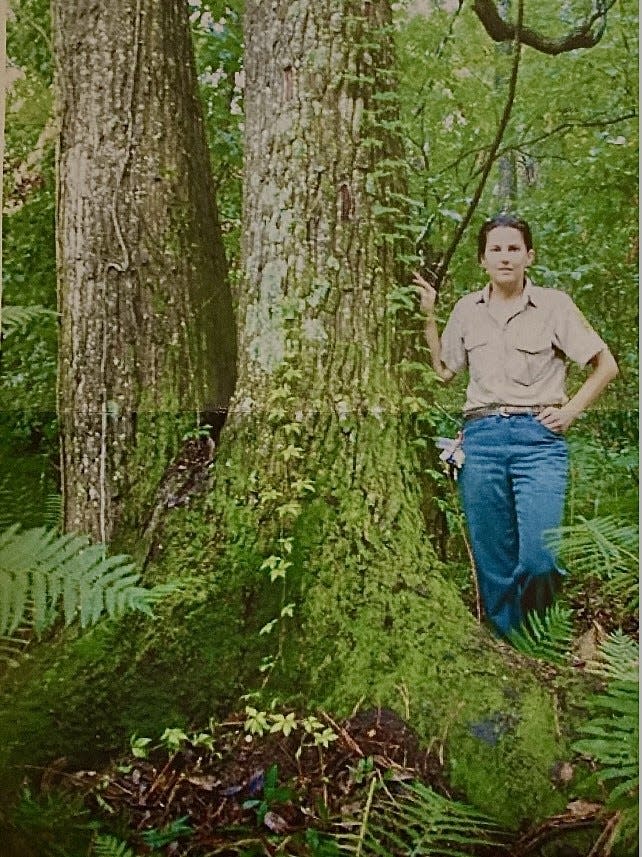Mark Woods: If a national champion falls in our woods ... we still have remarkable trees

A national champion from Jacksonville fell recently. This champion wasn’t a football team. And it wasn’t a figurative tumble.
A loblolly bay in the Jacksonville Arboretum came crashing down across a boardwalk, built so people could walk into the woods and get a good look at the twin-trunked champ.
It might’ve happened at night. Nobody was hurt. And while the tree destroyed part of the railing, the boardwalk came out remarkably intact. But it’s closed for now, the fallen champ lying across it.
Lad Hawkins walked me out to it the other day.
Hawkins is a retired architect who lives near the Arboretum in Arlington. He has been involved with the Arboretum since its opening in 2008. He helped lay out many of the trails and build some of the bridges and boardwalks — including years later, the one for the champ.

“The loblolly bay and the honeysuckle azalea grow on a slope next to the wetland,” he said. “My mom always called it the Goldilocks slope — not too wet, not too dry. At the Arboretum, we probably have five or six places where they grow.”
When he first stumbled upon this particular loblolly bay, and realized it wasn’t two trees but one that had split, he wondered where it ranked among the species found across the Southeast with the scientific name of Gordonia Iasianthus.
In the world of trees, national champions aren’t decided by subjective polls, playoffs or, as some like to needle my UCF friends, self-proclamation. These national champions are based on measurements, a points system involving a combination of trunk circumference, height and average crown. The tree with the most points in its species is crowned champion and retains that belt for as long as it’s standing, unsurpassed by any other tree.
Florida lists a bald cypress in Hamilton County as the current largest native tree in the state, with a circumference of more than 46 feet, a height of 84 feet and a crown spread of 49 feet.
That state champion isn’t the national champion, though. A bald cypress in Louisiana holds that title.
When foresters came out and measured the loblolly bay in the Arboretum, with a diameter of 46 inches and a height of 117 feet it narrowly edged out another loblolly bay that was measured in the Timucuan Preserve. That second tree, in the Theodore Roosevelt Area of the park, was close enough that it was declared an "emeritus national co-champion."
Plans were made to build the boardwalk at the Arboretum leading to the champ. When Lad Hawkins told his mother about this, she said she wanted to do something to help. She donated the money for the lumber and he designed the boardwalk and, with a team of volunteers, built it.
Through the years, there have been signs that the champ might fall someday.
About four years ago volunteers noticed a large crack at the base of the tree about four years ago. The Arboretum newsletter said that Marc White “came to the rescue.” The Jacksonville businessman and certified arborist donated labor and materials and, with a team, worked to stabilize the tree with three steel rods in the trunk area and cabling at the top.
“I hope she stands for a long time," White said at the time.
Looking at her now, Hawkins said one of the questions is what to do with all that wood. Some have suggested making musical instruments, tables and chairs.
Another question is where exactly is the second loblolly bay, the one in the Theodore Roosevelt Area of the Timucuan Ecological Historic Preserve.
While at the Arboretum, we happened to bump into Larry Figart — the forester who, it turns out, measured that loblolly bay.
“I remember we had to go traipsing through the woods to get to it,” he said.
It also isn’t the only champ still standing in Jacksonville.
According to a state database, Duval County has two more national champion trees: the tough bumelia, sometimes called a “tough bully” (a 34-foot version of the small tree) and co-champion slash pine (132 feet tall, with a circumference of more than 11 feet).
Not that many people are going to point to either of those as their favorite tree.
But I’m sure many do have a favorite tree. Maybe one that might not be the tallest or oldest, but is your personal champion.
'Remarkable Trees Project'
Scenic Jacksonville is partnering with Hidden Jacksonville, a small business with a large social media following, for what is being called the “Remarkable Trees Project.”
People are being asked to go online and share a picture of a shade tree that “has captured your heart and imagination.” Hidden Jacksonville will use the responses to populate Google maps with the locations of the trees.
“The idea is to get people to pay attention to their trees and be proud of their trees,” said Hawkins, who is on the Scenic Jacksonville board.
It could be a single tree or a grove. It doesn't necessarily have to set any records. It just should have some meaning.
“Remarkable and special trees are not always giant trees,” Hawkins said.
He tells the story of the golden rain tree in the backyard of his childhood home in Louisiana. His sister got married under it. So did some other relatives.
The tree was beautiful when it was blooming. But, as Hawkins explains, rain trees are considered nuisance trees. They spread seedlings all over the surrounding area. And as this tree grew bigger and bigger, little rain trees began popping up everywhere.
Lad told his mother, Julia Hawkins, they should cut it down.
“She said, ‘We can’t cut that tree down,’” he said.
They didn’t, but that golden rain tree eventually died of old age —and was survived by lots of rain trees.
His mother is still standing at age 107.
When she ran the 50- and 100-meter dashes in the National Senior Games at age 103, she was believed to be the oldest woman to formally compete on an American track. The New York Times did a story about her. President Obama commented on his admiration of her. And then she broke that record when she ran the 100 again at 105.
While she has since stopped running, Lad says his mother is doing well and will turn 108 in February. He also mentions that she has a picture hanging on her living room wall, a painting that an artist did during the Arboretum’s “Brush with Nature” event.
It’s of the national champion loblolly bay.
When I walked across Jacksonville a few years ago, Lad led me through the Arboretum, including a detour to see that tree. Walking there again the other day to see it now, he looked on the bright side.
There might be a new champ in town. But it is in town. The national champion loblolly bay still in Jacksonville, on public land. And beyond that, beyond any titles, we have all kinds of remarkable trees.
To submit trees for the Remarkable Tree Project, or to learn more, go to: www.hiddenjacksonville.com/remarkabletrees.
mwoods@jacksonville.com, (904) 359-4212
This article originally appeared on Florida Times-Union: National champion loblolly bay tree falls in Jacksonville woods

